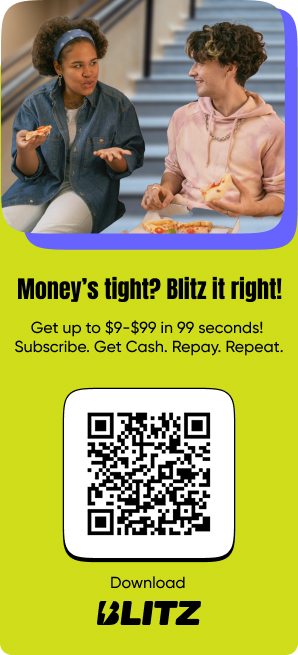You know that feeling when subscriptions pile up without warning? Signing up for a notes app or a cloud drive for one class seems small until the monthly total suddenly looks like a full week of groceries. That’s frustrating.
For students, every dollar matters. Those $5 or $10 charges quietly stack up to $40 or more. This money can cover food, books, or savings. The good news is there is no need to give up favorite shows, music, or study tools; make smarter subscription swaps.
Blitz makes this possible. It tracks subscriptions, flags hidden costs, and suggests cheaper alternatives that help you save $20–$50 per month. In this blog, find easy swaps for the apps that drain budgets the most without losing what matters.
Ready to keep the tools, cut the cost, and free up cash for what counts next? Let’s dive in.
The Hidden Cost of Expensive Apps
Small expenses rapidly accumulate. One or two subscriptions do not seem to cause any harm, then a few more come in, and the monthly total suddenly becomes a part of food, books, and weekend plans. Here are some hidden costs:
The “Subscription Creep” Problem
Subscription creep happens when small payments stack up over time. At $5 to $15 per app, the numbers may seem harmless, but the total grows quickly when you have several services at once.
- Paying $10 for music, $15 for streaming, and $5 for cloud storage already makes $30 each month.
- Adding a study tool and fitness app could raise that to $50 each month.
- In a year, that equals $600, which is more than the cost of many course materials.
With just two or three apps, you might already be spending more than you realize.
Why Students Feel the Pinch More
Students feel the effects of subscription creep more than most because their budgets are already tight. Many rely on digital tools for both academics and entertainment, which makes it harder to cut back. Some key challenges include:
- Tool-heavy coursework
Classes often require cloud storage, note apps, citation tools, and collaboration platforms. Adding these to personal streaming and music multiplies costs. - Shared spaces, shared screens
Dorm life means headphones, offline downloads, and cross-device access. Paying extra for features to cope with shared spaces can inflate monthly totals. - Semester swings
Some apps are critical only during specific courses. Keeping them active all year wastes money when a switch to pause or downgrade would do the job. - Overlap with campus access
Universities already offer premium tools for free or nearly free. Paying for a duplicate app is common when campus perks are not checked first.
For students, the choice is often between paying for these apps or covering essentials like groceries and textbooks.
Streaming Services – Cheaper Entertainment Options
Entertainment is one of the first places where small subscription costs start stacking up. Streaming movies, music, and shows is almost a necessity of college life, but if you pay the full price for every platform, your budget will evaporate very fast. Here are some cheaper options:
Netflix vs. Free or Low-Cost Alternatives
Netflix is popular, but it is also one of the pricier options. Students can save by checking out free or cheaper platforms. Here are some apps:
- Peacock Free Tier has a changing slate of shows and movies for free.
- Pluto TV offers free live TV and on-demand movies.
Even if you retain Netflix, interspersing these free sources helps you reduce binge-watching expenses.
Spotify/Apple Music vs. Student Discounts & Bundles
Music is a daily essential for the majority of students, but paid subscriptions can be heavy to bear. Fortunately, discounts ease the burden.
- Spotify Student Plan comes with Hulu and Showtime bundled at a much lower price.
- Apple Music Student offers the same catalog at a reduced student rate.
These substitutions allow you to still play your favorite playlists without sacrificing half your budget. Here’s How to Use DealsGPT for Subscription Service Trial Extensions.
Premium Cable/OTT Subscriptions vs. Shared Plans
Cable and large OTT packages can be expensive, particularly when you only watch a couple of channels. Shared plans help spread the cost legally and fairly.
- Family or group subscriptions to services such as Netflix, Hulu, or Disney+ enable you to share costs with your roommates.
- OTT bundles sometimes include student discounts when tied to your campus account.
- Sharing responsibly lowers monthly bills for everyone without missing content.
It is not cutting entertainment out; it’s keeping access smart.
Productivity & Cloud Tools – Affordable Replacements
School assignments, collaborative work, and independent assignments all depend on digital tools. But the cost of subscriptions can take a bite out of a student’s budget. Here are some low-cost alternatives:
Microsoft Office vs. Free Student Access or Google Workspace
Before spending money on Office, check if your school already gives it for free. Here are some apps:
- The student version is mostly free for various apps such as Word, Excel, PowerPoint, and OneDrive.
- Google Workspace (Docs, Sheets, Slides) is cloud-based and free.
- LibreOffice is an offline-compatible, open-source alternative that is very similar to Office.
These choices enable you to complete your assignments and group projects without paying additional fees.
Adobe Creative Cloud vs. Low-Cost or Free Design Tools
The monthly cost of Adobe apps is quite high, although the applications themselves are quite powerful. Luckily, several free or low-cost tools cover the most creative needs, which you can use.
- Canva is very convenient when you need to make fast graphics, presentations, or social media designs.
- Figma works perfectly for group design projects and UI/UX tasks.
- GIMP is basically Photoshop; only it is free and tailored for photo editing purposes.
These apps allow you to design, edit, and produce without being locked into expensive subscription fees.
Interesting: Quick Cash Solutions for College Students – A Smart Guide to Fast Money
Paid Cloud Storage vs. Free Options
Cloud storage is essential, but you do not need to pay unless you need a lot of space. Free plans can be enough for most students.
- Google Drive offers 15 GB for free with a Gmail account.
- OneDrive often comes free with student email accounts.
- Dropbox provides free storage and easy file sharing for group projects.
For most students, these options are plenty for assignments, resumes, and project files.
Fitness & Wellness Apps – Free or Cheaper Options
Health and wellness are just as important as grades, but paying for fitness and meditation apps can get expensive. Here are some free or cheaper options:
Gym Membership Apps vs. Free Fitness Platforms
Several exercise apps are $10 to $30 per month, but numerous cost-free resources are just as effective.
- YouTube exercise sessions include everything from strength training to yoga at no charge.
- FitOn provides home or dorm workouts led by expert trainers at no charge.
- Nike Training Club also gives you free workouts developed by pro trainers.
With them, you can create a routine that suits your budget and time.
Headspace/Calm vs. Free Meditation Apps
One of the major ways of combating stress is practicing mindfulness; however, meditation apps like Headspace or Calm may give a rather costly impression. Free or bundled options make it easier.
- Insight Timer has thousands of free guided meditations.
- UCLA Mindful provides simple sessions developed by mindfulness experts.
These options enable students to concentrate, refuel, and cope with stress without the expense of paid subscriptions.
Academic & Lifestyle Apps – Smart Substitutes
Learning, gaining new skills, and getting through the day frequently translate into subscribing to apps that appear useful but soon deplete your budget. Here are smart and free alternatives:
Paid Study Tools vs. Free Learning Platforms
Some study apps charge for features that you can get for free elsewhere. Students can still boost their learning without overspending.
- Quizlet’s free version still covers flashcards and study sets for exams.
- Grammarly’s free service catches frequent grammar and spelling mistakes.
Together, these tools address most study requirements without having to upgrade to premium accounts.
Language Learning Apps vs. Cheaper Choices
Learning a new language is rewarding, but popular apps often come with costly subscriptions. Free tools can be just as effective.
- Duolingo’s basic offering has daily lessons and practice.
- Library materials such as Mango Languages or free e-books are usually available using a student ID.
These choices keep language practice fun and affordable.
Expensive Food Delivery Apps vs. Smart Hacks
Food ordering can become expensive, let alone with delivery charges. Rather than using apps that take money out of your pocket, be smarter.
- Student meals at campus cafeterias are typically cheaper.
- Blitz cashback tools help you earn money back when you choose food apps or restaurants.
With these swaps, you can still enjoy good meals without watching your budget disappear.
The Beem/Blitz Angle – Smarter Spending With Subscription Swaps
Blitz is your AI-powered financial buddy, helping students manage their money easily. Instead of letting apps drain your wallet, Blitz tracks every subscription. It shows you where money is slipping away and offers smarter ways to save.
With Blitz, you can:
- Set reminders before renewals to avoid paying for forgotten apps.
- Monitor the amount of money you save as a result of a change to a more affordable provider.
- Use those savings for books, food, or your savings account, for example.
Using Blitz gives you more than just money tracking. It helps you spend smarter and stress less.
How Much You Can Actually Save by Swapping
It is amazing how rapidly small subscription fees add up when you consider the larger picture. Here’s a straightforward breakdown of what you can save:
- Streaming swaps can save about $10–$20 each month.
- Productivity and cloud tools can save $20–$40 each month.
- Fitness and wellness apps can save $10–$15 a month.
When you add it, the savings amount to over $500 a year.
Quick Checklist – Make the Most of Subscription Swaps
Reducing subscription expenses doesn’t have to be a headache. With a few quick steps, you can get your apps under control, stop wasting your spending.
- Review all subscriptions every month: Sit down for five minutes and review what you’re spending money on every month.
- Cancel what you don’t use often: If you opened an app just once or twice during the last semester, it’s time to uninstall it.
- Look for cheaper or free alternatives: Most apps have free alternatives or affordable substitutes that provide you with nearly the same functionalities.
- Track spending with Blitz: Blitz makes all your subscriptions appear before you, sends you reminders, and indicates where you can cut back.
Read: How to Use DealsGPT for Recurring Subscription Savings
Conclusion – Small Swaps, Big Wins
Subscriptions don’t have to empty your wallet. With a few smart ways, you can enjoy the same TV shows, music, study aids, and fitness programs for much less money. However, small changes quickly pay off, converting unnecessary dollars into real savings.
Blitz makes this even easier. It monitors your subscriptions, alerts you to any extra charges, and lets you know about the most affordable alternatives that best suit your lifestyle. No surprise bills or forgotten apps devouring your budget.
Start using Blitz today to gain control over your digital expenditure. Smarter subscriptions mean more freedom, more savings, and extra money for what matters most to you.
FAQs on Subscription Swaps
How do I find cheaper alternatives to popular apps?
Start with free versions or student discounts. Many schools also give access to paid tools at no extra cost—check your student email perks before paying.
Is sharing subscriptions with friends safe and legal?
Yes, as long as the app allows multiple streams or family plans. Always stick to the platform’s official sharing rules.
Which expensive subscriptions should students cancel first?
Cancel the ones you haven’t used in the last month. Gym apps, premium streaming, and cloud storage are common budget drains.
Can free apps really replace premium features?
For most students, yes. Free tools cover the essentials—writing, designing, studying, or working out. Premium features are often nice extras, not necessities.
How does Blitz help track and manage subscriptions?
Blitz is the all-in-one place where you can have full access to your subscriptions. It is where you get a warning before a renewal and where you keep track of your savings if you change a subscription to a cheaper alternative.





